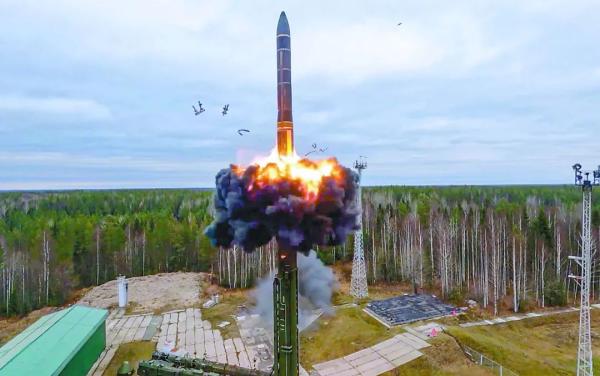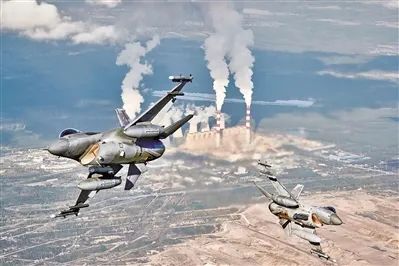Two nuclear deterrence exercises have captured extensive attention in the international community recently. One is NATO’s Steadfast Noon exercise from October 17 to 30, involving 14 NATO state members and about 60 aircraft. It is followed by Russia’s Grom-2022 nuclear exercise from October 26 to 29. Will the two exercises with partly overlapping schedule accelerate the arrival of a nuclear war? Here is an exclusive interview with retired Major General Jin Yinan.

Question: NATO started its Steadfast Noon nuclear deterrence exercise on October 17 despite Russia’s repeated and rigorous warnings. The half-month-long exercise features the most advanced warplanes, reconnaissance planes and refueling planes and involves the deployment of nuclear weapons and response to nuclear attacks. What would you say about it?
Jin Yinan: The leading figure in NATO’s Steadfast Noon nuclear exercise is the US, whose number of nuclear warheads is disproportionally larger than the combined amount possessed by other NATO countries together. Russia’s Grom-2022 large-scale strategic nuclear exercise deserves close attention too. They present us with an extremely rare situation after the Cold War.
The US military also plans to deploy its latest upgraded B61 nuclear bombs in Europe at the end of this year. If these nuclear bombs with higher precision and smaller equivalent are used on the European battlefield, Europe will be directly affected. In the entire European history, WWI and WWII razed the continent to the ground twice. Whether it wants to join this nuclear adventure again is something Europe needs to think seriously about.

Question: It is reported that the main purpose of the Steadfast Noon nuclear exercise is to try out NATO’s nuclear sharing policy, which means the US deploys nuclear weapons on the soil of its NATO allies, who participate in the bloc’s nuclear activities by providing bases and warplanes, thus obtaining the capability of nuclear deterrence. At the moment, Germany, Italy, the Netherlands and Belgium have deployed America’s B61 nuclear bombs that can be carried by their own military aircraft. Pentagon plans to deploy the new B61-12 nuclear bombs in Europe next month – earlier than the original plan. What consequences will come out of America’s forward deployment of tactical nuclear weapons and lowering of the nuclear threshold?
Jin Yinan: America’s new B61-12 nuclear bombs have a smaller explosive equivalent, higher precision, and the ability to penetrate the earth’s surface. Everybody knows that a smaller equivalent makes it easier to use them as tactical nuclear weapons. If the US used them in a war, Russia and the US were likely to use nuclear weapons with more destructive power, which might escalate to strategic nuclear weapons if the situation kept heating up, till eventually a nuclear war broke out. Escalation would be inevitable if Pandora’s box was opened.
In my opinion, every European country that has deployed America’s nuclear warheads, such as Belgium, the Netherlands and Italy, is in a dangerous position. They always think that arming themselves with those warheads will make them more secure, but that’s not how it works – they will only put them on the line. This reminds me of 1989. When the news about the collapse of the Berlin wall reached the ears of then-US President Bush, he kept in a low profile . Many US media felt dissatisfied and called him scared of the Soviet Union, but his national security advisor Condoleezza Rice said the president just dared not ignite a match in a room full of gas. At that time, the nuclear weapons possessed by the US and Russia were enough to guarantee much destruction, and nobody came out as a winner from a nuclear war. I think that makes a lot of sense. NATO’s recent nuclear exercise only serves to imperil Europe and the entire region.
Question: In response to the nuclear deterrence from NATO, Russia held its GROM-2022 annual nuclear exercise from October 26 to 29, causing commentators to say that the risk of global nuclear war has come to the highest level in the past 60 years. Is the tit-for-tat between NATO and Russia going to increase the possibility of a nuclear war?
Jin Yinan: We cannot completely exclude the possibility of a nuclear war now. Regarding the Russia-Ukraine conflict, China’s consistent position is that both sides should calm down and talk a way out without escalation. But the West and NATO don’t think that way. NATO has come to provide weapons and ammunition to Ukraine directly – costing it tens of billions of US dollars already with no sign of stop – including sophisticated weapons and equipment. Now it is deploying tactical nuclear bombs.
The US and some NATO members are convinced that Russia is very likely to use tactical nuclear weapons in Ukraine, which is why they have accelerated the deployment of such weapons in Europe in response. But that has only stimulated Russia to pace up in deploying the weapons too and exercising its nuclear forces. As a result, the conflict gets increasingly heated and the possibility of war emerges. If the two sides don’t cool their head and exercise restraint in a timely manner, if they don’t truly realize what a hell a nuclear war will throw the world into, we indeed cannot exclude the possibility of such a war.













